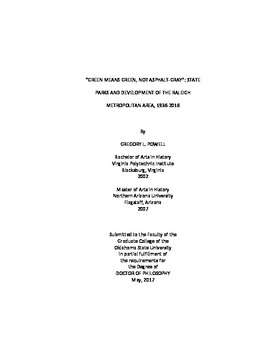| dc.contributor.advisor | Bryans, William S. | |
| dc.contributor.author | Powell, Gregory L. | |
| dc.date.accessioned | 2018-03-13T18:16:17Z | |
| dc.date.available | 2018-03-13T18:16:17Z | |
| dc.date.issued | 2017-05 | |
| dc.identifier.uri | https://hdl.handle.net/11244/54595 | |
| dc.description.abstract | State parks are a ubiquitous presence on the American landscape with thousands of units in all fifty states that attract far more visitors than the U.S. National Park System. While the sheer diversity and number of state parks can be daunting, their pervasiveness also positions state parks as valuable sources of gauging economic, social, cultural, environmental, and historic development of given locales. This study examines the establishment and development of four units of the North Carolina state parks system located near the state capital of Raleigh and a large, forest tract owned by Duke University often mistaken for a state park by area resident to examine cultural changes that occurred in the region accompanied by rapid urbanization from the 1960s to the present. This urbanization was characterized by the arrival of large numbers of individuals from outside the region who represented the shift from a rural, agricultural region to a densely populated area with large numbers of highly educated, white collar workers in technology industries associated with area research universities. | |
| dc.description.abstract | In this context, the development of recreational opportunities in the form of state parks, which dates to the 1930s, illustrated this rapid expansion of the Raleigh metropolitan area in terms of motivations for their establishment and influences upon their development that involved local, state, regional, and national trends and politics. This included processes such as New Deal-era efforts to utilize denuded farm land for recreation, centrality of recreation to post-World War Two urbanization and suburbanization, 1950s- and 1960s-era desegregation efforts, efforts to procure drinking water and implement flood control measures, and the emergence of the "modern" environmental movement. These processes and events, and the interactions of individual residents, politicians, grassroots organizations, university officials, and municipal bodies illustrate the role of politics and ideology upon environmental perspectives, which may be observed in the presence and development of the region's state parks. | |
| dc.format | application/pdf | |
| dc.language | en_US | |
| dc.rights | Copyright is held by the author who has granted the Oklahoma State University Library the non-exclusive right to share this material in its institutional repository. Contact Digital Library Services at lib-dls@okstate.edu or 405-744-9161 for the permission policy on the use, reproduction or distribution of this material. | |
| dc.title | Green means green, not asphalt gray: State parks and development of the Raleigh metropolitan area, 1936-2016 | |
| dc.contributor.committeeMember | Logan, Michael F. | |
| dc.contributor.committeeMember | Kinder, John | |
| dc.contributor.committeeMember | Wikle, Tom | |
| osu.filename | Powell_okstate_0664D_15140.pdf | |
| osu.accesstype | Open Access | |
| dc.type.genre | Dissertation | |
| dc.type.material | Text | |
| thesis.degree.discipline | History | |
| thesis.degree.grantor | Oklahoma State University | |
